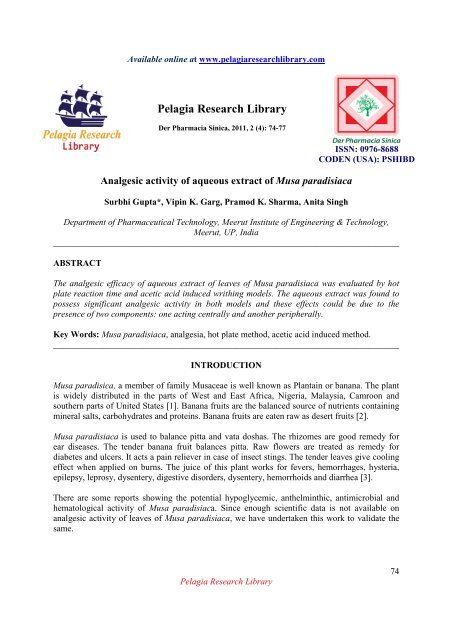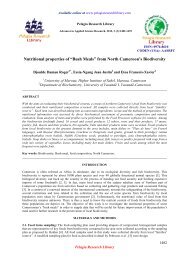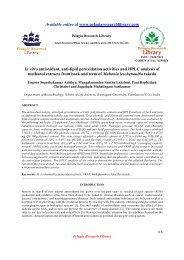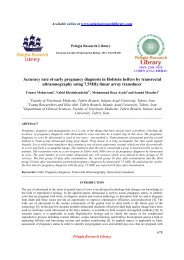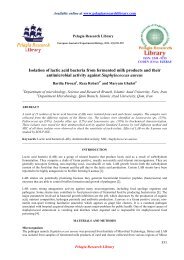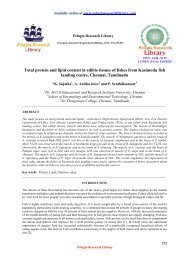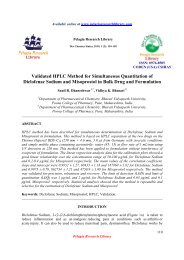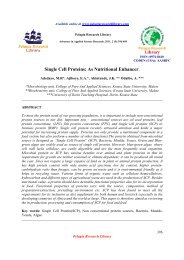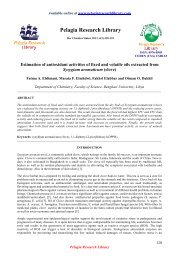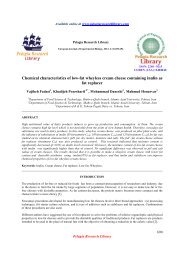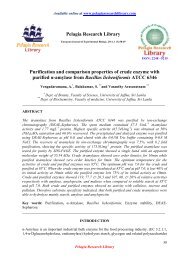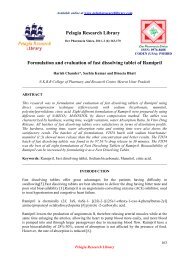Analgesic activity of aqueous extract of Musa paradisiaca - Pelagia ...
Analgesic activity of aqueous extract of Musa paradisiaca - Pelagia ...
Analgesic activity of aqueous extract of Musa paradisiaca - Pelagia ...
You also want an ePaper? Increase the reach of your titles
YUMPU automatically turns print PDFs into web optimized ePapers that Google loves.
Available online at www.pelagiaresearchlibrary.com<br />
<strong>Pelagia</strong> Research Library<br />
Der Pharmacia Sinica, 2011, 2 (4): 74-77<br />
<strong>Analgesic</strong> <strong>activity</strong> <strong>of</strong> <strong>aqueous</strong> <strong>extract</strong> <strong>of</strong> <strong>Musa</strong> <strong>paradisiaca</strong><br />
Surbhi Gupta*, Vipin K. Garg, Pramod K. Sharma, Anita Singh<br />
ISSN: 0976-8688<br />
CODEN (USA): PSHIBD<br />
Department <strong>of</strong> Pharmaceutical Technology, Meerut Institute <strong>of</strong> Engineering & Technology,<br />
Meerut, UP, India<br />
______________________________________________________________________________<br />
ABSTRACT<br />
The analgesic efficacy <strong>of</strong> <strong>aqueous</strong> <strong>extract</strong> <strong>of</strong> leaves <strong>of</strong> <strong>Musa</strong> <strong>paradisiaca</strong> was evaluated by hot<br />
plate reaction time and acetic acid induced writhing models. The <strong>aqueous</strong> <strong>extract</strong> was found to<br />
possess significant analgesic <strong>activity</strong> in both models and these effects could be due to the<br />
presence <strong>of</strong> two components: one acting centrally and another peripherally.<br />
Key Words: <strong>Musa</strong> <strong>paradisiaca</strong>, analgesia, hot plate method, acetic acid induced method.<br />
______________________________________________________________________________<br />
INTRODUCTION<br />
<strong>Musa</strong> paradisica, a member <strong>of</strong> family <strong>Musa</strong>ceae is well known as Plantain or banana. The plant<br />
is widely distributed in the parts <strong>of</strong> West and East Africa, Nigeria, Malaysia, Camroon and<br />
southern parts <strong>of</strong> United States [1]. Banana fruits are the balanced source <strong>of</strong> nutrients containing<br />
mineral salts, carbohydrates and proteins. Banana fruits are eaten raw as desert fruits [2].<br />
<strong>Musa</strong> <strong>paradisiaca</strong> is used to balance pitta and vata doshas. The rhizomes are good remedy for<br />
ear diseases. The tender banana fruit balances pitta. Raw flowers are treated as remedy for<br />
diabetes and ulcers. It acts a pain reliever in case <strong>of</strong> insect stings. The tender leaves give cooling<br />
effect when applied on burns. The juice <strong>of</strong> this plant works for fevers, hemorrhages, hysteria,<br />
epilepsy, leprosy, dysentery, digestive disorders, dysentery, hemorrhoids and diarrhea [3].<br />
There are some reports showing the potential hypoglycemic, anthelminthic, antimicrobial and<br />
hematological <strong>activity</strong> <strong>of</strong> <strong>Musa</strong> <strong>paradisiaca</strong>. Since enough scientific data is not available on<br />
analgesic <strong>activity</strong> <strong>of</strong> leaves <strong>of</strong> <strong>Musa</strong> <strong>paradisiaca</strong>, we have undertaken this work to validate the<br />
same.<br />
<strong>Pelagia</strong> Research Library<br />
74
Surbhi Gupta et al Der Pharmacia Sinica, 2011, 2(4):74-77<br />
______________________________________________________________________________<br />
MATERIALS AND METHODS<br />
Plant material<br />
The leaves <strong>of</strong> <strong>Musa</strong> <strong>paradisiaca</strong> were collected from the local area <strong>of</strong> Meerut district and<br />
identified and authenticated by Dr. Anjula Pandey, Principal Scientist, National Herbarium <strong>of</strong><br />
Cultivated Plants, NewDelhi. Voucher specimens (NHCP/NBPGR/2011-18/7264) have been<br />
kept in National Herbarium <strong>of</strong> Cultivated Plants, New Delhi and Department <strong>of</strong> Pharmaceutical<br />
Technology, MIET for future reference.<br />
Animals<br />
Healthy albino mice <strong>of</strong> both sexes weighing between 20 – 25g were used. Institutional Animal<br />
Ethics Committee approved the experimental protocol. Animals were maintained under standard<br />
conditions in an animal house approved by Committee for the Purpose <strong>of</strong> Control and<br />
Supervision on Experiments on Animals (CPCSEA). (Approval No. 711/02/a/CPCSEA).<br />
Extraction<br />
The leaves were dried under shade, reduced to moderately coarse powder, and were macerated<br />
with hot water for 48 hours to get the <strong>aqueous</strong> <strong>extract</strong> <strong>of</strong> <strong>Musa</strong> <strong>paradisiaca</strong> leaves. The <strong>aqueous</strong><br />
<strong>extract</strong> was concentrated to dryness using Rotary evaporator, giving yield as 7.240% w/v. and<br />
preserved in a refrigerator. Aliquot portions <strong>of</strong> the <strong>aqueous</strong> <strong>extract</strong> <strong>of</strong> <strong>Musa</strong> <strong>paradisiaca</strong> were<br />
weighed and suspended in an appropriate volume <strong>of</strong> Tween 80 (2% v/v) for use on each day.<br />
Preliminary Phytochemical Studies<br />
The <strong>aqueous</strong> <strong>extract</strong> was then subjected to qualitative Phytochemical screening for the<br />
identification <strong>of</strong> different phytoconstituents. Aqueous <strong>extract</strong> showed positive tests for the<br />
presence <strong>of</strong> alkaloids, carbohydrates, sterols, proteins and flavonoids. As traditionally, the plant<br />
is used to cure pain, the analgesic <strong>activity</strong> <strong>of</strong> the <strong>aqueous</strong> <strong>extract</strong> <strong>of</strong> the plant in different dose<br />
levels (250mg/kg, 1000 mg/kg) [4] is being reported here.<br />
<strong>Analgesic</strong> <strong>activity</strong><br />
Hot plate method and acetic induced writhing models were used to evaluate the analgesic <strong>activity</strong><br />
<strong>of</strong> <strong>aqueous</strong> <strong>extract</strong> <strong>of</strong> <strong>Musa</strong> <strong>paradisiaca</strong>.<br />
Hot Plate Method<br />
The hot plate method described by Turner (1965) was followed for the assessment <strong>of</strong> analgesic<br />
<strong>activity</strong>. Albino mice were introduced to a hot plate maintained at 55 ± 0.5°C. The reaction time<br />
to the thermal stimulus was recorded as the time interval from introduction <strong>of</strong> the animal to the<br />
plate until the first lick <strong>of</strong> the limbs or the first jump <strong>of</strong> the animals. The test groups received<br />
<strong>aqueous</strong> <strong>extract</strong> <strong>of</strong> <strong>Musa</strong> <strong>paradisiaca</strong> at different dose levels prepared as suspension in 2%<br />
Tween 80 orally, the standard group received Pentazocine (10 mg/kg) [5] and control group<br />
received only 1 ml <strong>of</strong> 2% Tween 80 solution. The reaction times were determined before and<br />
after 30 minutes, 1 hour, 2 hours and 3 hours period with reference to the control group receiving<br />
only vehicle.<br />
<strong>Pelagia</strong> Research Library<br />
75
Surbhi Gupta et al Der Pharmacia Sinica, 2011, 2(4):74-77<br />
______________________________________________________________________________<br />
Acetic Acid Induced Writhing<br />
Acetic acid induced writhing response in mice Acetic acid solution at a dose <strong>of</strong> 10ml/kg (0.6%)<br />
was injected i.p. and the number <strong>of</strong> writhes during the following 15 minutes period was<br />
observed. The test groups received <strong>aqueous</strong> <strong>extract</strong> <strong>of</strong> <strong>Musa</strong> <strong>paradisiaca</strong> at different dose levels<br />
prepared as suspension in 2% Tween 80 orally, the standard group received Aspirin (10 mg/kg)<br />
[5] and control group received only 1 ml <strong>of</strong> 2% Tween 80 solution orally. Significant reductions<br />
in number <strong>of</strong> writhes by drug treatment as compared to vehicle treatment animals were<br />
considered as a positive analgesic response. The percent inhibition <strong>of</strong> writhing was calculated<br />
[5].<br />
% Inhibition = WC – WT x 100<br />
WC<br />
Where,<br />
WC = Mean number <strong>of</strong> writhes in control group.<br />
WT = Number <strong>of</strong> writhes in test group.<br />
Statistical Analysis [6]<br />
All the results obtained from various activities, as described above, were analyzed statistically by<br />
using Student’s t test and p
Surbhi Gupta et al Der Pharmacia Sinica, 2011, 2(4):74-77<br />
______________________________________________________________________________<br />
DISCUSSION<br />
The present study establishes the analgesic activities <strong>of</strong> the <strong>aqueous</strong> <strong>extract</strong> <strong>of</strong> <strong>Musa</strong> <strong>paradisiaca</strong><br />
in the models used. Since analgesic activities are commonly mentioned as characteristic <strong>of</strong> drugs<br />
or compounds which have an inhibitory effect on prostaglandin biosynthesis [7]. This result<br />
seems to support the view that the <strong>extract</strong> has some influence on prostaglandin biosynthesis [8].<br />
The analgesic <strong>activity</strong> <strong>of</strong> <strong>aqueous</strong> <strong>extract</strong> <strong>of</strong> the plant was evaluated using the hot plate method<br />
and writhing test in mice. The hot plate method is useful in detecting centrally acting analgesics<br />
[8] whereas acetic acid induced writhing method is useful to detect peripheral analgesic effects.<br />
Acetic acid, which is used as an inducer for writhing syndrome, causes algesia by liberation <strong>of</strong><br />
endogenous substances, which then excite the pain nerve endings [9]. The fact that <strong>aqueous</strong><br />
<strong>extract</strong> <strong>of</strong> <strong>Musa</strong> <strong>paradisiaca</strong> showed analgesic <strong>activity</strong> in both the models studied, indicate that<br />
this effect could be due to the presence <strong>of</strong> two components; one acting centrally and the other via<br />
peripheral route [9]. From the above results, it can be deduced that <strong>aqueous</strong> <strong>extract</strong> has shown<br />
dose dependent <strong>activity</strong>. As the phytochemical screening has shown the presence <strong>of</strong><br />
carbohydrates, sterols, proteins, flavonoids, alkaloids in <strong>aqueous</strong> <strong>extract</strong> <strong>of</strong> <strong>Musa</strong> <strong>paradisiaca</strong><br />
leaves, its potent <strong>activity</strong> may be attributed to the presence <strong>of</strong> these phytoconstituents. More<br />
detailed phytochemical studies are, however, necessary to identify the active principle(s) and<br />
exact mechanism <strong>of</strong> action.<br />
CONCLUSION<br />
From the above study, it can be concluded that the <strong>aqueous</strong> <strong>extract</strong> <strong>of</strong> <strong>Musa</strong> <strong>paradisiaca</strong> leaves<br />
possesses analgesic <strong>activity</strong>.<br />
Acknowledgement<br />
The authors are thankful to Dr. Anjula Pandey, Principal Scientist, National Herbarium <strong>of</strong><br />
Cultivated Plants, National Bureau <strong>of</strong> Plant Genetic and Resources, New Delhi for identification<br />
and authentication <strong>of</strong> the plant and also to the Department <strong>of</strong> Pharmaceutical Technology, MIET,<br />
Meerut for providing research facilities to carry out the work.<br />
REFERENCES<br />
[1] A. E. Olorunfemi, S. Obot, U. Jackson, A. Akeem, International Journal <strong>of</strong> Phytopharmacy<br />
Research, 2010, 1, 21-24.<br />
[2] O.S. Adeyemi, A. T. Oladiji, African Journal <strong>of</strong> Biotech, 2009, 8, 5, 858-859.<br />
[3] http://www.ayurveda-recipes.com/banana.html<br />
[4] A Eseyin, Olorunfemi, Oladoja Aw<strong>of</strong>isayo, I. Etim, S. Jackson, J. Anim Biomed. Science,<br />
2010, 5(3), 115-117.<br />
[5] G. Puchchakayala., L. Podili, D. Bobbala, Phcog.Mag, 2008, 4(13), 32-36.<br />
[6] S. K. Kulkarni; Handbook <strong>of</strong> Experimental Pharmacology, Vallabh Prakashan, New Delhi,<br />
2002.<br />
[7] J. R. Vane, Drug, 1987, 33, 8-27.<br />
[8] A. S. Milton, Trends in Pharmacological Sciences, 1982, 40, 490-492.<br />
[9] N. Narayanan., P. Thirugnanasambantham, S. Viswanathan, V. Vijayasekaran, E. Sukumar,<br />
J. Ethanopharmacol, 1999, 65, 237-241.<br />
<strong>Pelagia</strong> Research Library<br />
77


